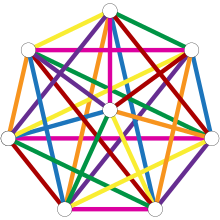20:
290:
442:
97:
176:
140:
361:
589:
334:
462:
381:
186:
vertices forms a hyperedge; a 1-factor of this hypergraph is a set of hyperedges that touches each vertex exactly once, or equivalently a
205:
612:
386:
444:
colors so that the edges of each color form a perfect matching. Baranyai's theorem says that we can do this whenever
562:
52:
575:
493:
485:
607:
143:
70:
187:
149:
113:
583:
529:
511: = 3 case was established by R. Peltesohn in 1936. The general case was proved by
489:
28:
339:
313:
537:
525:
512:
477:
447:
366:
48:
24:
19:
601:
550:
481:
40:
554:
533:
544:, Colloquia Math. Soc. János Bolyai, vol. 10, North-Holland, pp. 91–107
108:
56:
496:, and its solution was already known in the 19th century. The case that
528:(1975), "On the factorization of the complete uniform hypergraph", in
18:
16:
Theorem that deals with the decompositions of complete hypergraphs
285:{\displaystyle {\binom {k}{r}}{\frac {r}{k}}={\binom {k-1}{r-1}}}
198:
vertices of the hypergraph may be partitioned into subsets of
476: = 2 case can be rephrased as stating that every
296:-element subset appears in exactly one of the partitions.
488:, or equivalently that its edges may be partitioned into
542:
Infinite and Finite Sets, Proc. Coll. Keszthely, 1973
450:
389:
369:
342:
316:
208:
152:
116:
73:
456:
436:
375:
355:
328:
284:
170:
134:
91:
437:{\displaystyle {\binom {n}{2}}{\frac {2}{n}}=n-1}
406:
393:
276:
247:
225:
212:
383:vertices, and we wish to color the edges with
8:
588:: CS1 maint: location missing publisher (
572:Das Turnierproblem für Spiele zu je dreien
190:of the vertices into subsets of size
449:
412:
405:
392:
390:
388:
368:
347:
341:
315:
275:
246:
244:
231:
224:
211:
209:
207:
162:
157:
151:
126:
121:
115:
72:
292:different ways, in such a way that each
480:with an even number of vertices has an
67:The statement of the result is that if
581:
7:
194:. Thus, the theorem states that the
35: = 2 of Baranyai's theorem
182:vertices, in which every subset of
484:whose number of colors equals its
397:
251:
216:
14:
1:
492:. It may be used to schedule
27:on 8 vertices into 7 colors (
92:{\displaystyle 2\leq r<k}
336:, we have a complete graph
47:(proved by and named after
629:
563:Cambridge University Press
613:Theorems in combinatorics
559:A Course in Combinatorics
171:{\displaystyle K_{r}^{k}}
135:{\displaystyle K_{r}^{k}}
63:Statement of the theorem
494:round-robin tournaments
576:Inaugural dissertation
570:Peltesohn, R. (1936),
458:
438:
377:
357:
330:
286:
172:
136:
93:
36:
459:
439:
378:
358:
356:{\displaystyle K_{n}}
331:
287:
178:is a hypergraph with
173:
137:
94:
22:
448:
387:
367:
340:
314:
310:In the special case
206:
150:
114:
107:, then the complete
71:
329:{\displaystyle r=2}
167:
131:
454:
434:
373:
353:
326:
282:
168:
153:
132:
117:
89:
45:Baranyai's theorem
37:
490:perfect matchings
457:{\displaystyle n}
420:
404:
376:{\displaystyle n}
274:
239:
223:
99:are integers and
51:) deals with the
29:perfect matchings
23:A partition of a
620:
593:
587:
579:
565:
561:(2nd ed.),
545:
463:
461:
460:
455:
443:
441:
440:
435:
421:
413:
411:
410:
409:
396:
382:
380:
379:
374:
362:
360:
359:
354:
352:
351:
335:
333:
332:
327:
306:
291:
289:
288:
283:
281:
280:
279:
273:
262:
250:
240:
232:
230:
229:
228:
215:
177:
175:
174:
169:
166:
161:
142:decomposes into
141:
139:
138:
133:
130:
125:
98:
96:
95:
90:
628:
627:
623:
622:
621:
619:
618:
617:
598:
597:
580:
569:
551:van Lint, J. H.
549:
524:
521:
470:
446:
445:
391:
385:
384:
365:
364:
343:
338:
337:
312:
311:
308:
301:
263:
252:
245:
210:
204:
203:
148:
147:
112:
111:
69:
68:
65:
17:
12:
11:
5:
626:
624:
616:
615:
610:
600:
599:
596:
595:
567:
547:
520:
517:
513:Zsolt Baranyai
504:is also easy.
500: = 2
478:complete graph
469:
466:
453:
433:
430:
427:
424:
419:
416:
408:
403:
400:
395:
372:
350:
346:
325:
322:
319:
307:
298:
278:
272:
269:
266:
261:
258:
255:
249:
243:
238:
235:
227:
222:
219:
214:
165:
160:
156:
129:
124:
120:
88:
85:
82:
79:
76:
64:
61:
53:decompositions
49:Zsolt Baranyai
25:complete graph
15:
13:
10:
9:
6:
4:
3:
2:
625:
614:
611:
609:
606:
605:
603:
591:
585:
577:
573:
568:
564:
560:
556:
555:Wilson, R. M.
552:
548:
543:
539:
535:
531:
527:
526:Baranyai, Zs.
523:
522:
518:
516:
514:
510:
505:
503:
499:
495:
491:
487:
483:
482:edge coloring
479:
475:
467:
465:
451:
431:
428:
425:
422:
417:
414:
401:
398:
370:
348:
344:
323:
320:
317:
304:
299:
297:
295:
270:
267:
264:
259:
256:
253:
241:
236:
233:
220:
217:
201:
197:
193:
189:
185:
181:
163:
158:
154:
145:
127:
122:
118:
110:
106:
102:
86:
83:
80:
77:
74:
62:
60:
58:
54:
50:
46:
43:mathematics,
42:
41:combinatorial
34:
30:
26:
21:
571:
558:
541:
508:
506:
501:
497:
473:
471:
309:
302:
293:
202:vertices in
199:
195:
191:
183:
179:
104:
100:
66:
55:of complete
44:
38:
32:
31:), the case
608:Hypergraphs
57:hypergraphs
602:Categories
538:Sós, V. T.
530:Hajnal, A.
519:References
109:hypergraph
515:in 1975.
464:is even.
429:−
300:The case
268:−
257:−
188:partition
144:1-factors
78:≤
584:citation
578:, Berlin
557:(2001),
540:(eds.),
534:Rado, R.
103:divides
468:History
486:degree
590:link
507:The
472:The
84:<
363:on
305:= 2
39:In
604::
586:}}
582:{{
574:,
553:;
536:;
532:;
146:.
59:.
594:.
592:)
566:.
546:.
509:r
502:r
498:k
474:r
452:n
432:1
426:n
423:=
418:n
415:2
407:)
402:2
399:n
394:(
371:n
349:n
345:K
324:2
321:=
318:r
303:r
294:r
277:)
271:1
265:r
260:1
254:k
248:(
242:=
237:k
234:r
226:)
221:r
218:k
213:(
200:r
196:k
192:r
184:r
180:k
164:k
159:r
155:K
128:k
123:r
119:K
105:k
101:r
87:k
81:r
75:2
33:r
Text is available under the Creative Commons Attribution-ShareAlike License. Additional terms may apply.
